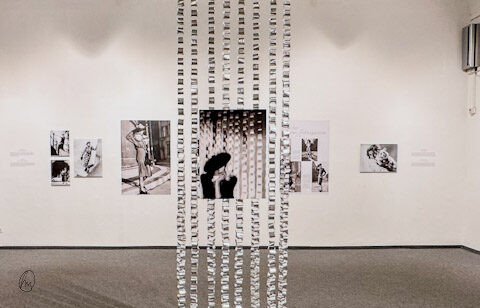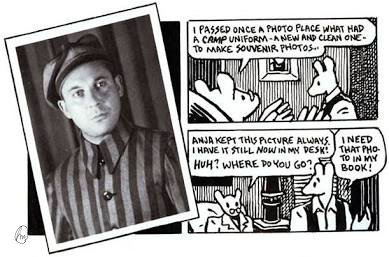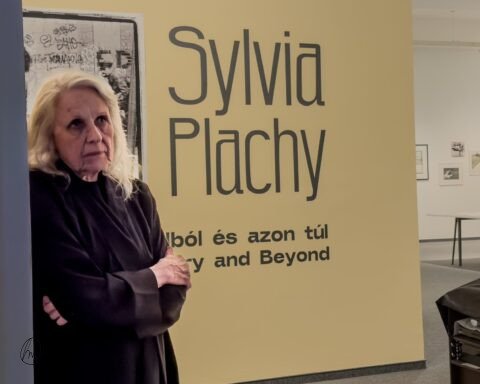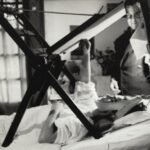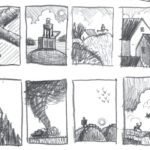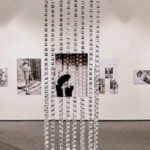The opposite of glam depiction, a reformer of fashion photography, a storyteller: Peter Lindbergh — the photographer who showed the world that a woman’s value goes far beyond clothes, makeup, and glittering backdrops.
In plain terms: the exact opposite of what the fashion world was promoting at the time. He was the man who let models’ personalities shine through the image. The one who stripped them of their functional label — the coat hanger. The destroyer of tight, old-school glam. The herald of natural beauty. He presented women from an entirely new perspective.
“The woman is always more important than the dress she wears.”

Early Years
Born in 1944 in a small German industrial town, Lindbergh spent his childhood isolated from culture — a time he remembers as poor, yet happy. Just a kid playing handball, from a grimy little town — from a Germany that had sunken into silence*. He dropped out of school early to start working, at a time when his mother would’ve sent him down the practical path of tiling. But Lindbergh had other plans, and with his father’s permission, he ended up working as a window dresser — what became a turning point in his life, sparking his interest in the arts. (Big shoutout to the dad right there!) After a brief and unsuccessful detour in Switzerland, he moved to Berlin and began studying painting.
The Paineter
Though initially satisfied with his paintings, Lindbergh, to his own surprise, gave up on the idea of becoming a painter after a pivotal experience at a German art forum. There, for the first time, he encountered the greatness of contemporary American painting — works so bold, so alive, they made his own “daubings” look like laughable mediocrity in comparison. Rightfully so. After that, Lindbergh was still a drifting greenhorn, working day-labor gigs in farmers’ barns across Europe — often in exchange for nothing more than a spot to spend the night. At the time, he had no idea what kind of turn life was about to take. One day, after enough relentless mocking from his friends, he returned to Berlin and started working as a photography assistant. What a stroke of luck — having friends like that, right?
“I wanted to break away from the prescribed image of the perfectly shaped woman — the one who isn’t real… I was drawn to a bolder, more outspoken kind of woman who takes charge of her own life… That’s what the supermodels came to represent.”
Lindbergh shaped his ideal of womanhood based on the girls he met during his art school time in Berlin — girls whose outfits meant more than just decoration. He was inspired by free-spirited, meaningful, bohemian women, and the models became the storytellers of his messages.


Peter Lindbergh had found his way out. And as a result, the female ideal could finally break free from the object-focused, unrealistic grip of glam. From what Hollywood had built up until then: the unattainable, iconic starlet look and those product-centered model images. For a while, at least, women could breathe easier. And for that, he deserves our thanks.
He soaked up technical knowledge like a sponge — just as he himself was swept up by European photography. He began his career at Stern magazine.
Come on now — freeing women through supermodels? Sounds like a stretch, doesn’t it?
Yes, yes, hold on. Stay with me. Keep reading.
It’s true that he photographed the most beautiful women in the world. But from the very start of his career, he stood firmly against makeup and artificiality — anything that masked the unique features women carry, which are the very essence of their beauty. He was looking for the real woman.
On a foundation of trust, he captured those raw black-and-white portraits — where you could see the bag under the eye, the tiny scar below the lip, the piercing gaze, the life. With those, he rewrote the definition of fashion photography as it was known.

“…black-and-white photography is often more authentic than color. Especially in portraits, the effect is stronger thanks to the reduction. Of course, this inner belief — that black-and-white somehow brings us closer to reality — is completely false. But perhaps it also shows just how deeply I was influenced by American photojournalism of the 1930s and 1940s — photographers like Dorothea Lange, Walker Evans, and many others.”
Lindbergh always consciously avoided Vogue, the long-established fashion magazine that dominated in the leading countries of the fashion world. He found the publication demotivating. He repeatedly turned down their offers, unable to align with their philosophy. As a result, the breakthrough that would have launched him onto the world stage never came — at least not then.
Of course, there was no need to worry about Lindbergh. He made a good living from photography — after all, he was the one turning down the assignments. Right? Right! Without a doubt, this is what photographic authenticity looks like.
The rejections escalated until one day, Alexander Liberman himself — then the art director of American Vogue — called Lindbergh personally. During that call, he offered him the chance to choose anyone he wanted from the creative team and take them on a shoot. That gold-plated offer of total creative freedom was impossible to turn down — especially since Lindbergh had always held a deep respect for the magazine, even if he knew how it would end. The differences in how they viewed fashion photography were still razor-sharp.
And with that, we arrive at a turning point in the history of fashion photography.
The Birth of the Supermodels – Spotlight on the Individual
The models were taken out of the well-known sterile environment of studios and placed into real spaces — out into life. They became storytellers. They were set in situations that inspired, that raised questions.
During that pivotal 1988 shoot in New York, the Vogue crew was told that the makeup artist and stylist had nothing to do beyond simply being present. The models wore plain white shirts that didn’t distract from what really mattered: the individual. Throughout the session, Lindbergh let the models freely enjoy the windy ocean shore, while he captured their essence, their freedom, and their personality.

“The lowest you can get, you can have – and that is yourself. It’s just about yourself. If you stand to yourself and you, I mean, you dare to be yourself – then I think you are beautiful.”
Naturally, when the photos were developed, the rusting old Liberman didn’t get them at all. Outraged, he tossed them “in the trash.”
But — six months later, Liberman was no longer anywhere near American Vogue.
Anna Wintour – Vogue – The new definiton of beauty
The prestigious seat had been taken over by Anna Wintour — yes, that Anna Wintour, who’s still there to this day. Yes, The Devil Wears Prada and all that… Well, one day, that Anna pulled those very same photos out of the archives — and their impact led her to commission a 14-page editorial from Peter Lindbergh. This became his debut in American Vogue.
And it also happened to be Anna Wintour’s very first American Vogue cover.
Now listen up.
What Made That Cover So Groundbreaking?
The model, Michaela Bercu, is laughing genuinely, without makeup, in jeans and a cropped sweater — on the cover of a magazine that had been shaping the female ideal since 1892. And on top of that, the shot took place outdoors — not in a perfectly lit, sterile studio. Suddenly, on the glossy pages of a luxury fashion magazine, there appeared the innocent charm of a high school like beauty. And she was selling a Christian Lacroix haute couture cropped jacket.
Brilliantly, by the way.

Healthy beauty. A relatable ideal. A stripped-back image.
Memory of the early years
His childhood memories of the industrial town — the influence of machinery, the material of iron itself — pierced through like light into his fashion photography as well.
One of his most thought-provoking series features top models (Michaela Bercu, Linda Evangelista, Kristen Owen) posed in a factory setting. It was fashion-politically charged. It raised questions. These almost makeup-free girls — previously used as cogs in the fashion industry’s studio machines — were now photographed in a raw, industrial environment. It broke from tradition. It threw glam in the trash.

One more interesting fact: it was the owner of the Japanese brand Comme des Garçons who commissioned Lindbergh for that shoot. He promised the photographer full creative freedom — with just one condition: the inspiration had to come from the current collection.
Why does Peter Lindbergh’s work matter today?
One: because right now, you have the chance to express your respect and gratitude to a man who, for nearly three decades, tried to portray female beauty in a healthy, grounded way.
A few of his works are currently exhibited at the Kunsthalle Budapest – Műcsarnok.
You can see original prints — of original beauties.
Women who broke out of the glam mold right on the covers of fashion magazines.
That matters.
Because we’re sinking into a world of factory-adjusted, artificially constructed ideals. A world where young people won’t show themselves without filters. We live in a time when preteens go live online after plastic surgery, wearing several-inch-long nails, faces fully made up — adding even more pressure to those who are still trying to stay authentic.
Peter Lindbergh’s work — like Untold Stories — should be passed from hand to hand the way today’s celebrity lies are passed around, warping reality.
Because real beauty is timeless.

“Very high scene quality, I don’t know which really is this, because I mean either you can go into detail and start decorating your pictures and decorating the people you photograph and… so that is not timeless, I think. Because all the decoration – it’s going to look old in 10 years or 15 years. And if you strip everything away and take a minimalist approach to every portrait you do… then it is very difficult. Then you are automatically timeless, I think.”
You simply can’t capture Peter Lindbergh’s legacy in a single article — he left behind far more, and far more important messages, for millions of women.
Maybe in a future follow-up piece, we’ll get into more gems — like how it was Peter Lindbergh who suggested Linda Evangelista cut her hair short. That bold move amplified her unique beauty and launched her into becoming one of the most in-demand models of all time.
Germany sunken in silence usually use to descirbe the era after WWII. More about that here is a yet not translated article on Hungarian about Wim Wenderes who actually had good friendship with Lindbergh
Source:
Peter Lindbergh supermodel photographer, SHOWstudio, Models
All images featured in this article are linked to the work of Peter Lindbergh. Rights and royalties belong to the photographer and the respective editors or agencies that commisioned them. Their use here serves solely to reflect and honor the lagacy he left behind.
If you’d like to stay up tp date with more interesting reads like this – or just relax with some laid back culture content – feel free to subscribe to the newsletter at the bottom of the page.” If you do, please make sure to check the spam folder too, since the confirmation email might end up there (Heti Mocsok currently set up on the free version of the Mailchimp for budget reasons)

